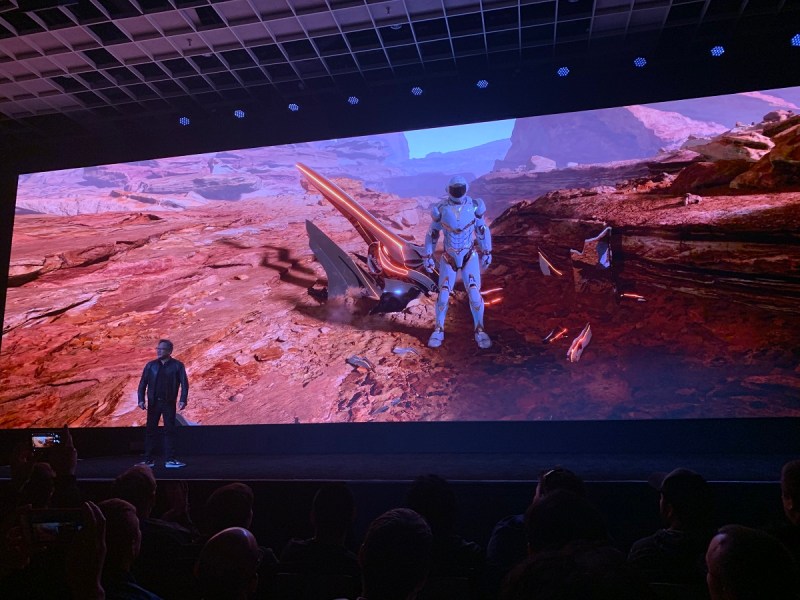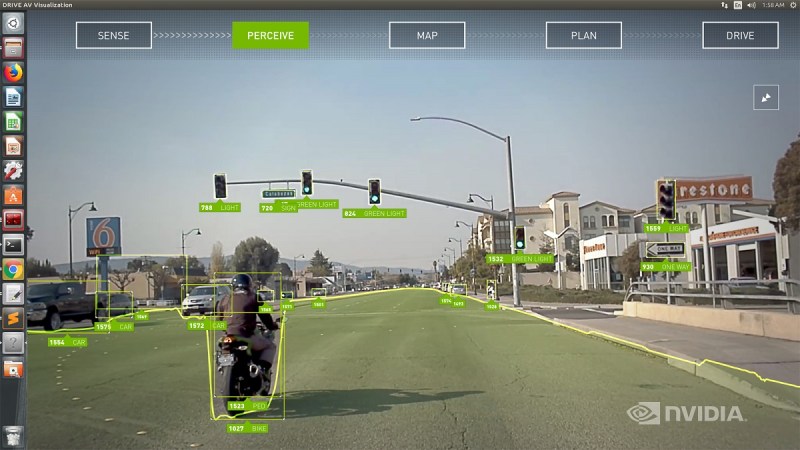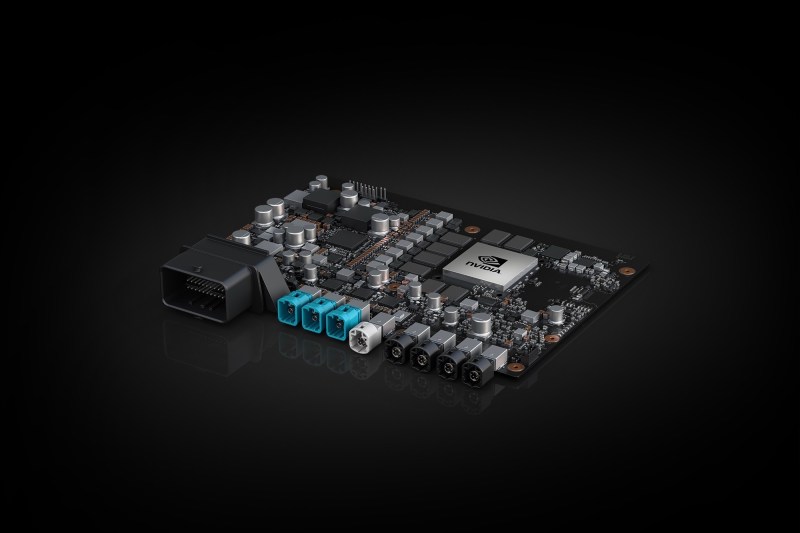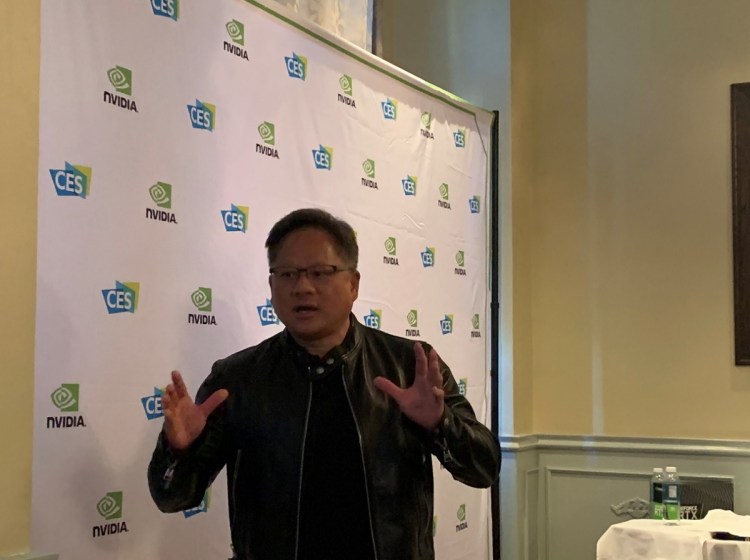Question: Can you talk about how tariffs and relations with China are possibly affecting your supply chain and selling into that market?
Huang: The tariff thing is not an issue for us. The reason for that is because all of our system assembly is largely done in Taiwan. It doesn’t really affect us. Our business in China — I hate to bring this word up. I’m not going to. No.
Our business, as you guys know, was affected because we have excess inventory. That’s largely been a near-term business factor for us. We announced that, because of the post-crypto decline, we had excess inventory approximately equal to something that would have taken us another one to two quarters to sell. That affected our business and our earnings, the guidance for this last quarter. What’s going to happen is, we will sell through all of our inventory post-crypto in the channel between one to two quarters from last quarter. The excess inventory in the channel has been reported so excessively that I hope you guys don’t need to report it again.
When you have something like that happen in China, happening all over the world — as far as we’re concerned, it’s not a factor in the longer term. Gaming is just fine. Gaming laptops had a record year in China last year. As far as I’m concerned, it’s fine.
June 5th: The AI Audit in NYC
Join us next week in NYC to engage with top executive leaders, delving into strategies for auditing AI models to ensure fairness, optimal performance, and ethical compliance across diverse organizations. Secure your attendance for this exclusive invite-only event.

Above: Real-time ray tracing scene on Nvidia RTX.
Question: Do you see any pickup in crypto?
Huang: God, I hope not. That’s my wish for this year. Can we all please — I don’t want anybody buying cryptocurrencies, okay? Stop it. Enough already. Or buy Bitcoin, don’t buy Ethereum.
Question: Have considered moving the manufacturing of some of your components to Mexico?
Huang: We manufacture wherever it makes sense. We manufacture with our partners. We don’t do manufacturing ourselves. We outsource all manufacturing. Wherever our major manufacturers manufacture, we love it. Manufacturing all over the world has the benefit of efficiency. That’s great. I support it.
Question: There’s been a lot of talk about 5G this year.
Huang: I’m happy to get 3G sometimes! I was making a phone call just now, was that 2.2G?
Question: How do you see the opportunity around that for Nvidia?
Huang: I don’t think it’s going to change anything. The reason for that is because you’ll never have perfect coverage everywhere. You’ll never have instant coverage, perfection, everywhere. You’ll always have to have hybrid cloud. That’s why your laptop has hybrid cloud. That’s why your phone has hybrid cloud. It’s essential. I don’t think it’s going to change anything. But when you download something, it will be a little faster. When you want to stream a movie, it’ll turn on faster. It’s good. I’m in favor of fast.
Question: John Hennessy and David Patterson have recently spoken about domain-specific computing as a new form of computer architecture. You recently added IOT Core and Tensor Core, these new domain-specific architectures, as well as Xavier. Are you going to add more and more domain-specific architectures into your GPUs or SOCs?
Huang: First of all, both Hennessy and Patterson, they were dual recipients of the Turing Award. It’s essentially the Nobel Prize for computer science. I can’t imagine two people, two friends that I consider more deserving.
The fundamental premise of domain-specific computing is that Moore’s Law has ended. That’s the beginning of the sentence. It’s not possible to continue to achieve performance without increasing cost or power, which means if you’d like two have two times the performance, it’ll cost you twice as much, or consume twice the power. Moore’s Law used to mean 10x growth every five years, 100x every 10 years. Right now we’re growing at a few percent per year. Every 10 years, maybe only 2x, maybe only 4x. It used to be 100x. Moore’s law has finished.
If you look at what a GPU is, the G is not “general.” The G is “graphics.” It was a domain-specific processor. We took the GPU, which is very good at linear algebra and simultaneous equations. Simultaneous multi-variable equation-solving is essentially what computer graphics is about. You could apply the basic approach of this domain processor, the GPU, to some other domains. Over the years, with Cuda, we very carefully opened up the domains a little bit at a time. But it’s not general-purpose. In fact, the GPU is the world’s first — Cuda is the world’s first domain-specific processor. That’s the reason why, in every single talk, Hennessy and Patterson referenced the GPU. We’re in every single one of their talks, because we’re the perfect example of a first in that area.
We’re very careful to select what domains we’ll build to serve. I completely believe in domain-specific architectures. We have three basic domain languages. With a domain-specific architecture you need a domain-specific language. The world’s first DSL was invented by a company called IBM. The name of that language was SQL. SQL is probably today the most popular domain-specific language still in IT. It’s designed for one purpose: file systems and storage. It’s domain-specific computing. That language is very powerful and very useful.
Then we invented a domain-specific language called cuDNN. That’s the SQL of deep learning. We invented another domain-specific language recently called Rapids. Rapids, you should look it up. It’s really important. It’s the DSL of machine learning. Not deep learning, but machine learning. Then we invented another DSL called Optics, which is the language of RTX. Optics is what inspired Microsoft’s DXR and Vulkan RT. We created these domain-specific languages.

Above: Nvidia’s autopilot can sense pedestrians and hazards.
Every market we go to, we have a domain-specific language. Every domain-specific language, underneath, has an architecture.
Question: Are you going to expand your domain-specific languages?
Huang: Yes, but very carefully. We don’t want to build a general-purpose chip. A CPU is a general-purpose chip.
Question: I’d like to get some of your thinking on why you named the new self-driving product Autopilot. Tesla has faced recriminations for naming its system, which has similar features, Autopilot. It conveys a level of autonomy beyond what it actually provides. Why that name? Are you worried about conveying something that it doesn’t actually provide?
Huang: We created the autonomous vehicle computing system. You can’t actually drive it. You still need wheels and other body parts. Whenever those cars come out, the manufacturers will figure out how they want to name things. The reason why we named it Autopilot is because it defines — today’s Model 3 and Model S that use Nvidia’s Drive PX, which is a few years old, somewhere between one-fifth and one-tenth the performance of Xavier — it defines the state of the art in level 2 driving today.
Most people, when you say level 2, it’s hard to imagine what it is. There’s no popular version of level 2. But Autopilot is such a well-known entity that we thought it was a good way to calibrate people’s standards. We also think that every single future EV will have to have at least the capabilities that today’s Model 3 and Model S are shipping with respect to AD. Could you imagine where the Model 3 and the Model S are going to be in 2021, in terms of software sophistication? It’s going to be incredible.
Question: The problem, as you say, is that people don’t understand it, so you’re trying to formulate a term that works. But I think that term provides — it conveys more autonomy than it actually provides right now at level 2. Level 2 is basically ADAS, a more advanced ADAS. Calling it Autopilot….
Huang: First of all, level 2 is not meant to be just ADAS.
Question: It’s not meant to be, but that’s what it is at this point.
Huang: I know, which is a tragedy.
Question: But you’re saying it’s okay to call that Autopilot. I don’t see why that’s the case. If people are confused….
Huang: Well, what would you call it? ADAS, basically? I completely disagree. It is completely nonsense to compare what Tesla has in the Model S, in terms of autopilot capability, and then ADAS level 2. It’s completely nonsense. We have to respect that company a little more than that. It drives me to work every day. It’s the only driver assistance software in a car that actually works, in my opinion. It’s getting better all the time.
Question: But “Autopilot” conveys a higher level of autonomy.
Huang: It’s just depends on what — they call it Autopilot. I’m fine with it. If you have another idea, that’s fine. But I think ADAS is wrong. Level 2 has been contaminated, has been destroyed by ADAS. Today’s L2, if you read the specifications of L2, it doesn’t say “ADAS Plus.” But unfortunately some people took an ADAS chip and added a bit of software to it and called it level 2. It’s a tragedy, and it’s going to change. Quite frankly I think that if everybody raised their car’s driving assistance functionality to the level of a Model S, it would be a very good thing.

Above: Nvidia’s new Xavier system-on-a-chip.
Question: In your autonomous driving work, why aren’t you yet aiming for level 3 or higher?
Huang: Because we should go to level 3 by walking through level 2+. The reason for that — the next-generation level 2+ will have tactile as well as AI driver monitoring to make sure you stay alert. There’s going to be a lot of functionality to make sure that when you are in charge, you stay in charge. You’re not dozing off or pretending to hold on to the steering wheel by hanging a pair of fake hands on there, something like that. You’re really going to have to pay attention.
Paying attention with Autopilot turned on is still wonderful. I do it every day. If you haven’t had the chance to enjoy it every day, you owe it to yourself to try it and then write about it. Try it every day and then write about it.
Level 5 is going to be a lot easier than level 3 and level 4. The reason for that is, at level 5 the speed is reduced. They’re taxis. They travel 30 miles per hour, which is fine in most cities. Level 3 and level 4, the car could be on a highway, because it’s a passenger-owned vehicle. I believe level 4 will happen. There’s no question about it. But we have to go step by step.
Question: How do you feel about the level of game support for RTX? It seems to be lagging a little.
Huang: With every single generation, we’ll start from zero. When we announced programmable shaders, we started from zero. When we announced tessellation we started from zero. When we announced displacement mapping we started from zero. It just has to go step by step.
The thing we’ve done with RTX is, baseline performance is so much better than the last generation. It’s the right GPU to buy no matter what. And number two, with every single new game that comes out, we’re either going to add DLSS to it, to enhance the imagery, or we’ll add DLSS and raytracing, turn all of raytracing on, as soon as we can. We’ll work with every developer for future games. As they get released we’ll add more and more.
Question: In Latin America, in places like Argentina, where I’m from, the value of the US dollar is shooting up. I’d love to have an Nvidia card, but they’re really expensive. What do you think about markets like this, where it’s becoming really difficult for us to afford video cards? Even a 2060 is still really expensive for us.
Huang: I don’t know the answer to that. The import tariffs are very high. I’ve heard of people flying to the United States to buy a camera or a TV and import it themselves. So I don’t know the answer. It’s really a question about everything in Latin America. I wish I had an answer.
Question: Can you talk more about the possibility of level 5 autonomous driving? We’ve heard people saying level 5 is impossible, but would you agree?
Huang: It depends on what level 5 is. Level 5 to me is a robot taxi. As far as I’m concerned, it’s not impossible. It’s not perfect. They have to keep refining it. But there’s every sign it will work. Some descriptions of level 5, they say you can drive it anywhere. You can’t drive under the ocean. In Arizona, within the digital fence, you can drive anywhere. That, to me, is level 5.
Question: What do you think about the viability of HBM (high bandwidth memory) in consumer products?
Huang: It’s just way more expensive for consumer products. But memory prices will come down. There’s nothing wrong with HBM. I love HBM. But I love GDDR6 (graphics memory) way more.

